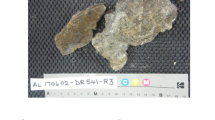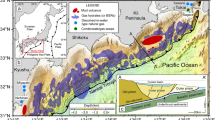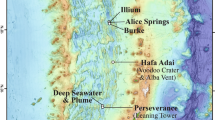Abstract
Submarine hydrothermal vents are a major source of methane to the oceans1,2. The methane, as well as H2 and CO, are generally believed to result from degassing of the mantle or from abiogenic water–rock reactions1, a conclusion supported by direct correlations between 3He and CH4, and generally between CH4, H2 and CO and dissolved silicate in hydrothermal waters2,3. An alternative source for these gases might be microbiological. This would imply that active bacterial communities exist in deep-sea hot water environments, some of which have temperatures exceeding 100 °C; this inference is without precedent. We have now found that the super-heated waters emanating from sulphide chimneys at 21 °N along the East Pacific Rise and samples from the sulphide chimneys themselves harbour complex communities of bacteria capable of growing with generation times of 37–65 min, producing CH4, CO, H2 and traces of N2O in media containing S2O2−3, Mn2+ and Fe2+ as energy sources, and oxidizing CH4, at 100 ± 2 °C at 1 atm. These microbial communities consist of three to five morphologically distinct types and include both oxidative and anaerobic species. These mixed cultures will not grow at temperatures below 70–75 °C. Even though some of the communities originated from water of temperatures >300 °C, it is not known if they can grow and produce CH4, CO and H2 in super-heated waters kept liquid due to hydrostatic pressure. The discovery of these obligately thermophilic, gas-producing and consuming bacterial communities associated with submarine volcanic environments has interesting and important implications for prokaryotic evolution, marine geochemistry, industrial microbiology and exobiology.
This is a preview of subscription content, access via your institution
Access options
Subscribe to this journal
Receive 51 print issues and online access
$199.00 per year
only $3.90 per issue
Buy this article
- Purchase on Springer Link
- Instant access to full article PDF
Prices may be subject to local taxes which are calculated during checkout
Similar content being viewed by others
References
Welhan, J. A. & Craig, H. Geophys. Res. Lett. 6, 829–831 (1979).
Lupton, J. E. & Craig, H. Science 214, 13–18 (1981).
Lilley, M. D. & Gordon, L. I. EOS 60, 863 (1979).
Corliss, J. B. et al. Science 203, 1073–1083 (1979).
Spiess, F. N. et al. Science 207, 1421–1432 (1980).
Hekinian, R., Fevrier, M., Bischoff, J. L., Picot, P. & Shanks, W. C. Science 207, 1433–1444 (1980).
Chen, C-T.A. Science 211, 298 (1981).
Williams, P. M., Smith, K. L., Druffel, E. M. & Linick, T. W. Nature 292, 448–449 (1981).
Karl, D. M., Wirsen, C. O. & Jannasch, H. W. Science 207, 1345–1347 (1980).
Jannasch, H. W. & Wirsen, C. O. Appl. envir. Microbiol. 41, 528–538 (1981).
Hiatt, B. Mosaic 11, 15–21 (1980).
Felbeck, H., Childress, J. J. & Somero, G. N. Nature 292, 291–293 (1981).
Brock, T. D. Thermophilic Microorganisms and Life at High Temperatures (Springer, New York, 1978).
Tansey, M. R. & Brock, T. D. in Microbial Life in Extreme Environments (ed. Kushner, D. J.) 159–216 (Academic, London, 1978).
Zeikus, J. G. Enzyme Microb. Technol. 1, 243–252 (1979).
Heinen, W. & Lauwers, A. M. Archs Microbiol. 129, 127–128 (1981).
Zeikus, J. G., Ben-Bassat, A. & Hegg, P. J. Bact. 143, 432–440 (1980).
Baross, J. A., Hanus, F. J. & Morita, R. Y. Appl. Microbiol. 30, 309–318 (1975).
Fyfe, W. S. Science 213, 105–110 (1981).
Corliss, J. B., Baross, J. A. & Hoffman, S. E. Oceanologica Acta No. SP, 56–69 (1981).
Zimmerman, R. & Meyer-Reil, L. A. Kieler Meeresforschungen 30, 24–27 (1974).
Rippka, R., Deruelles, J., Waterbury, J. B., Herdman, M. & Stanier, R. Y. J. gen. Microbiol. 111, 1–61 (1979).
Baross, J. A., Hanus, F. J. & Morita, R. Y. in Effects of the Ocean Environment on Microbial Activities (eds Colwell, R. R. & Morita, R. Y.) 180–202 (University Park Press, Baltimore, 1974).
Swinnerton, J. W. & Linnenbom, N. J. J. chromat. Sci. 5, 570–573 (1967).
Lilley, M. D., Baross, J. A. & Gordon, L. I. Deep-Sea Res. (in the press).
Harrison, M. J., Wright, R. T. & Morita, R. Y. Appl. Microbiol. 21, 698–702 (1971).
Baross, J. A., Hanus, F. J., Griffiths, R. P. & Morita, R. Y. J. Fish. Res. Bd Can. 32, 1876–1879 (1975).
Author information
Authors and Affiliations
Rights and permissions
About this article
Cite this article
Baross, J., Lilley, M. & Gordon, L. Is the CH4, H2 and CO venting from submarine hydrothermal systems produced by thermophilic bacteria?. Nature 298, 366–368 (1982). https://doi.org/10.1038/298366a0
Received:
Accepted:
Issue Date:
DOI: https://doi.org/10.1038/298366a0
This article is cited by
-
Geochemical and microbiological evidence for a hydrogen-based, hyperthermophilic subsurface lithoautotrophic microbial ecosystem (HyperSLiME) beneath an active deep-sea hydrothermal field
Extremophiles (2004)
-
Metabolic diversity in epibiotic microflora associated with the Pompeii wormsAlvinella pompejana andA. caudata (Polychaetae: Annelida) from deep-sea hydrothermal vents
Marine Biology (1990)
-
A laboratory experiment with relevance to the survival of micro-organisms entering a planetary atmosphere
Earth, Moon, and Planets (1986)
-
The biotechnological future for newly described, extremely thermophilic bacteria
Microbial Ecology (1986)
Comments
By submitting a comment you agree to abide by our Terms and Community Guidelines. If you find something abusive or that does not comply with our terms or guidelines please flag it as inappropriate.



